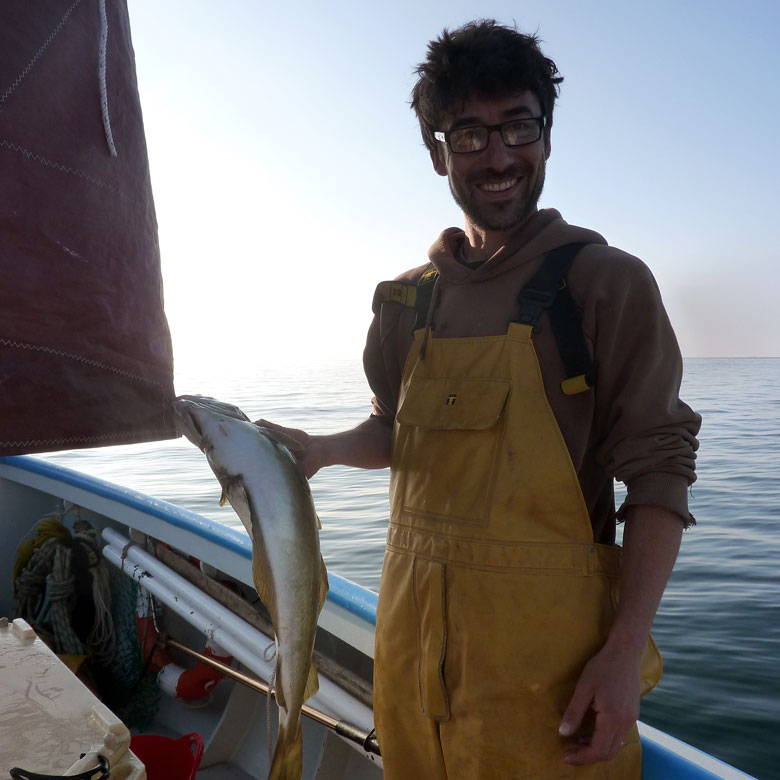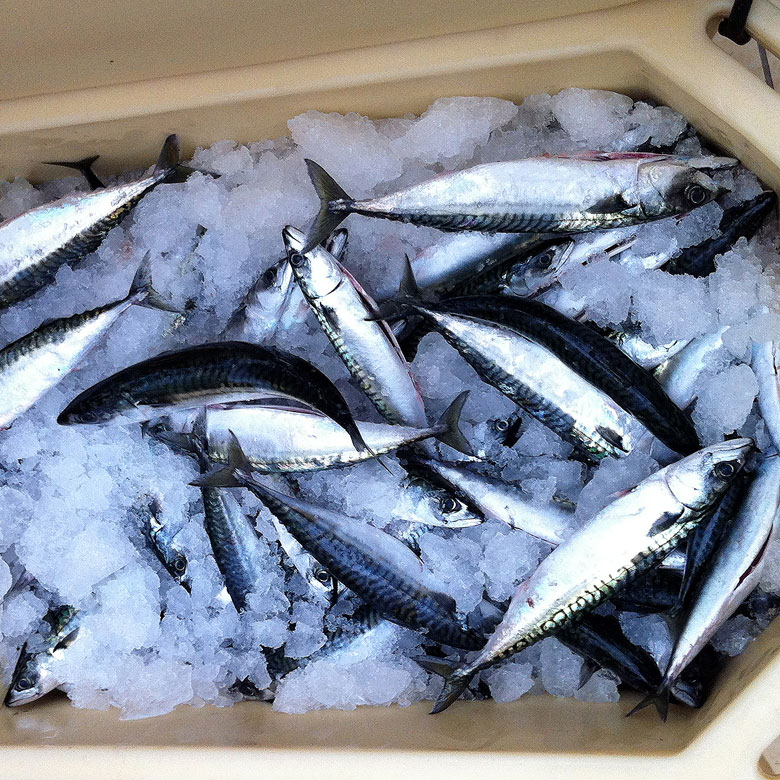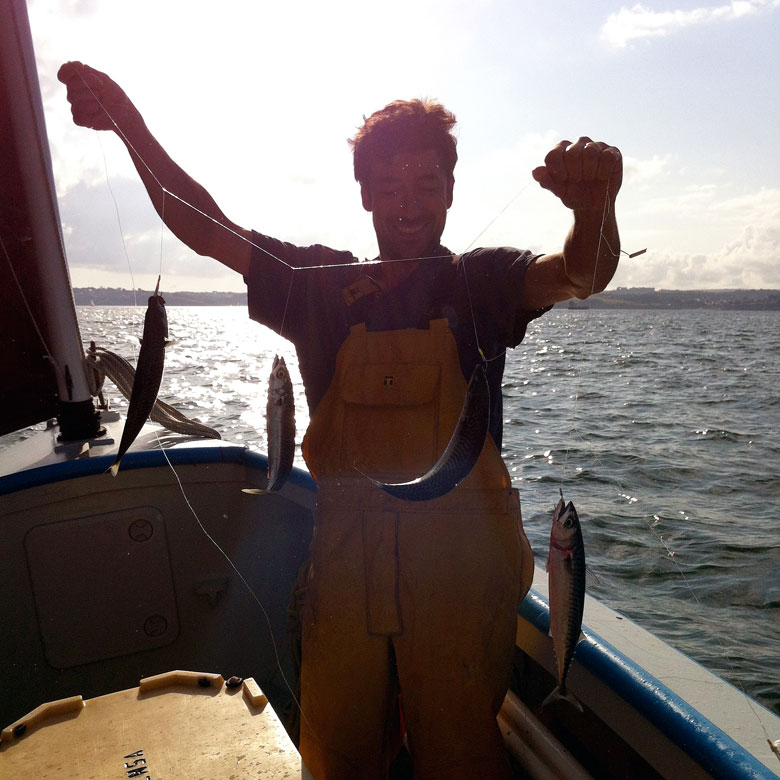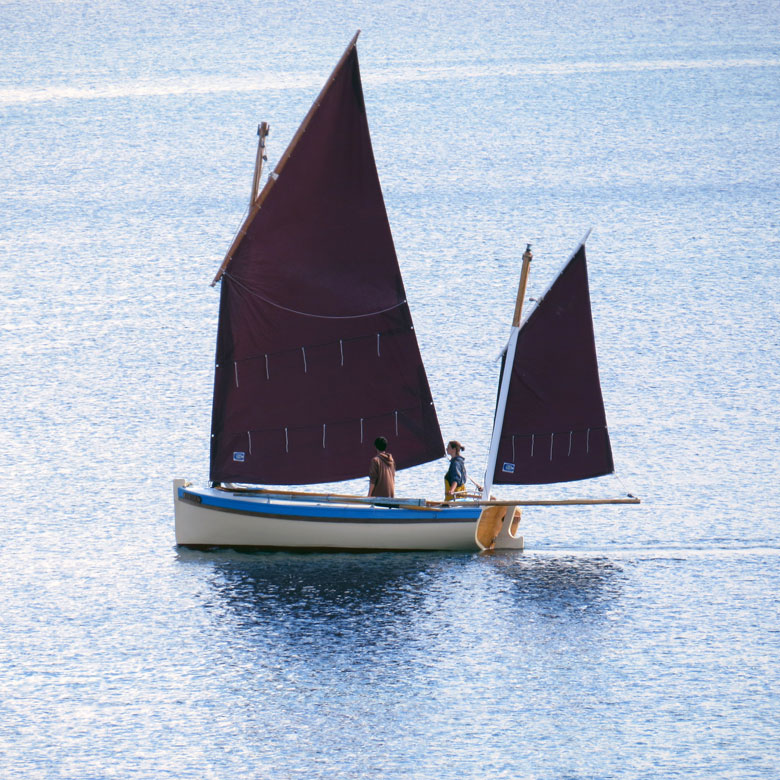Living the dream
Keen to “try something different”, Cat and Simon Holman built their own sailboat and now run a sustainable fishing business from their village in Cornwall. Alice Wright meets them.
The image of a small boat setting sail at dawn to catch mackerel off the coast of Cornwall may sound like something from a bygone era. But this is the reality of a working day for Cat and Simon Holman. Despite having no previous fishing experience, a few years ago they decided to build their own boat – powered only by sail and oar – and discover if it was possible to set up a sustainable fishing business from their Cornish village.
The idea came about after the couple took a couple of years out to sail around Greece. “We thought it would be nice to come home and not be driving an hour to work, so let’s try to do something different and work more from our village,” says Cat. “Fish was something that a lot of our villages in Cornwall were built on, but was no longer necessarily being used.”
She adds that both had an interest in local food, and had been frustrated by “ridiculous” food miles and how hard it was to find really fresh fish. Combining this with their love of sailing seemed to make sense – and when a magazine competition came up to design an eco-fishing boat it was the perfect opportunity to put their thinking to the test.
Simon, who studied Yacht Manufacture and Surveying, entered a design that came third in the competition. Back in their village of Portscatho, on the Roseland Peninsula, they decided to turn his prototype, and their idea for a sustainable fishing business, into a reality.
“We knew a few retired fishermen and people involved in fishing, so we decided before we embarked on anything we’d talk to them and if they said it was a ridiculous idea we’d think again,” says Cat. But the response was overwhelmingly positive. “The feeling was that there would be a good market for fish caught locally using low impact methods.”
So in March 2012 they began building Kensa, an 18ft (5.6m) engineless lugger, while taking advantage of free courses on offer in Cornwall for those going into the fishing industry, teaching skills such as food hygiene, health and safety and sea survival.
They also had to navigate the complex waters of fishing regulations, even though the boat was specifically designed to avoid the red tape and overheads associated with the industry – the annual price of a fishing vessel licence alone can be a significant cost for other businesses.
“If your boat is less than 10 metres long and has no engine then you’re not obliged to get registered, which means you don’t need a licence and don’t need a quota,” explains Simon. However, because their business model was relatively untested as far as industry regulation is concerned, Cat and Simon were conscientious about contacting all the relevant authorities to inform them of what they were doing and ensure they could show everything was above board.
But possibly the biggest challenge has been mastering the art of fishing. “I don’t think I knew how long it would take to learn to fish,” says Simon. Now in their third season, they feel they are only now really developing their understanding of what to target, and where and when to find it. “It’s all a bit trial and error,” says Simon. “The thing I keep learning is you never really figure it out, there are lots of variables.”
Currently they fish full-time in the summer months of June, July and August, focusing on mackerel, bass and pollack, though this year they are carrying on through September too and possibly beyond. “Mackerel is the main thing because it works well with a smaller boat,” says Simon. “We’ve got a market for it in the village and it sells well.”
As a small boat using traditional hand-lines and large mesh nets they can be very targeted about the types and species of fish they catch. Their bycatch is also very small, and as their nets are only down for short periods any bycatch they do produce can be returned to the sea alive, making it a more sustainable practice.
The couple will usually head out at first light – around 4am in the summer – aiming to be back by about midday to sell their catch to local pubs and restaurants for their specials boards. This has become their main market, as chefs value being able to buy such local, fresh produce. “It’s literally the freshest fish you can buy,” says Cat. “It’s quite rare to be able to get it straight off the boat.”

They would like to sell more to individuals but have found people often lack the confidence to tackle fish that hasn’t been pre-prepared. “People aren’t used to dealing with it,” says Cat. However, if they can convince people to take the plunge, they are soon converted by the quality and taste. To encourage more local people, and tourists, to give it a go, this year Cat and Simon are planning to sell fish from the beach in Portscatho.
It’s been a steep learning curve, but three years in Cat and Simon are proving that their vision of a small-scale, sustainable fishing business can work. And they hope their experiences could provide a model for others interested in doing something similar. They still rely on other freelance work during the winter, and this will probably always be the case. But as they become more confident in their boat and their own abilities, they hope to extend their working months and go out in rougher conditions.
They have come to accept that the nature of the industry means there will always be good days and bad, and they are unlikely to make their millions. But through vision and determination, Cat and Simon have managed to combine their passions for Cornwall, sailing and sustainable produce to create a business that works and – above all – they enjoy. As Cat puts it: “It’s nice to be out on a boat.”
Simon’s barbecued pollack
This is a good, simple recipe for using large round fish when catering for a lot of people. Pollack is inexpensive and takes flavour well, but this would also work with bass or cod. Using a whole fish is impressive and every bit of the fish gets used, which is less wasteful than filleting. There is plenty of scope for freestyling the exact combination of ingredients – the method is very simple and doesn’t involve any complex fish filleting, trimming or scaling.
Ingredients
- 1 large (2-3 kg) whole pollack, gutted
- 3 inches of ginger, peeled and sliced into thin sticks
- 4 or 5 spring onions, peeled and sliced into sticks
- 2 or 3 tablespoons light soy sauce
- 2 or 3 tablespoons of thick soy sauce
- 2 or 3 sticks lemongrass, peeled and cut into sticks
- 2 limes, zested and juiced
- 1 lemon, zested and juiced (but keep the husks)
Method
- Wash the fish and dry it. Make 3 or 4 diagonal cuts through the skin on each side of the fish.
- In a bowl, mix all the other ingredients apart from the thick soy sauce. Take 2 pieces of aluminium foil that are longer than the fish and lay them on the work surface, shiny side down.
- Lay a piece of greaseproof paper of the same length as the foil on top of the foil. Lay the fish on its back on the paper and open up the belly cavity.
- Put the 2 lemon husks inside the cavity at each end to hold the fish open. Pour all the other ingredients into the open fish and massage around a bit. The lemon should prevent too much liquid from running out of the head and gills but this might need fielding a bit…
- Holding the fish in one hand, wipe the thick soy sauce over the skin of the fish and into the slits in the skin. Wrap the greaseproof paper around the fish and crimp the ends and the seam into a tight a parcel as you can. The thick soy sauce acts as a sort of glue that holds it on the skin.
- Wrap the foil around the fish in 2 layers into a tight parcel. Put on to a hot barbecue and grill for around 20 minutes (depending on size), turn the fish over and grill for the same time on the other side.
- Carefully open the parcel and peel away the foil and then the brown paper. The paper should come away with the skin and fins, leaving you with a fragrant cooked fish that will lift away from the frame.

To find out more, or to buy fish from Cat and Simon, visit: portscathofish.co.uk








